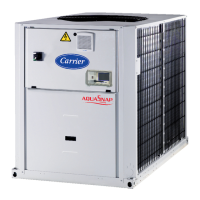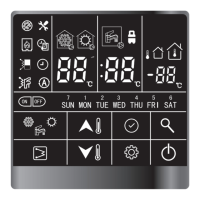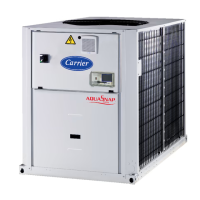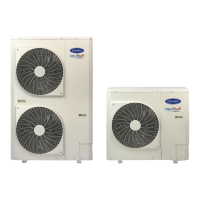8 - WATER CONNECTIONS
For size and position of the unit water inlet and outlet connections
refer to the certied dimensional drawings supplied with the unit.
The water pipes must not transmit any radial or axial force to the
heat exchangers nor any vibration.
The water supply must be analysed and appropriate desilting,
ltering, treatment, control devices, shut-o and bleed valves built
in, to prevent corrosion (example: damage to the protection of the
tube surface if the uid is polluted), fouling and deterioration of
the water circuit.
Before any start-up verify that the heat exchange uid is compatible
with the materials and the water circuit coating. The use of dierent
metals on hydraulic piping could generate eletrolytic pairs and
consequently corrosion. Verify then, the need to install sacricial
anodes.
In case additives or other uids than those recommended by
Carrier are used, ensure that the uids are not considered as a
gas, and that they belong to class 2, as dened in directive
2014/68/EU.
Carrier recommendations on heat exchange uids:
- No NH
4+
ammonium ions in the water, they are very
detrimental for copper. This is one of the most important
factors for the operating life of copper piping. A content of
several tenths of mg/l will badly corrode the copper over time.
- Cl
-
Chloride ions are detrimental for copper with a risk of
perforations by corrosion by puncture. If possible keep below
125 mg/l.
- SO
4
2-
sulphate ions can cause perforating corrosion, if their
content is above 30 mg/l.
- No uoride ions (<0.1 mg/l). - No Fe
2+
and Fe
3+
ions with non
negligible levels of dissolved oxygen must be present.
Dissolved iron < 5 mg/l with dissolved oxygen < 5 mg/l.
- Dissolved silica: silica is an acid element of water and can
also lead to corrosion risks. Content < 1mg/l.
- Water hardness: >0.5 mmol/l. Values between 0.5 and 1.5
mmol/l are recommended. This will facilitate scale deposit
that can limit corrosion of copper. Values that are too high
can cause piping blockage over time. A total alkalimetric titre
(TAC) below 100 is desirable in primary domestic hot water
loops and for heating applications.
- Dissolved oxygen: Any sudden change in water oxygenation
conditions must be avoided. It is as detrimental to
deoxygenate the water by mixing it with inert gas as it is to
over-oxygenate it by mixing it with pure oxygen. The
disturbance of the oxygenation conditions encou-rages
destabilisation of copper hydroxides and enlarge-ment of
particles.
- Electric conductivity 10-600 μS/cm
- pH: Ideal case pH neutral at 20-25°C (7.5<pH<9).
ATTENTION: Charging, adding or draining uid from the water
circuit must be done by qualied personnel, using air vents
and materials suitable for the products. The water circuit
charging devices are eld-supplied.
Charging and removing heat exchange uids should be done
with devices that must be included on the water circuit by the
installer.
8.1 - Operating precautions and
recommendations
The water circuit should be designed to have the least number of
elbows and horizontal pipe runs at dierent levels. Below the main
points to be checked for the connection:
- Comply with the water inlet and outlet connections shown on
the unit.
- Install manual or automatic air purge valves at all high points
in the circuit.
- Use a pressure reducer to maintain pressure in the system
and install a relief valve and an expansion tank.
- Units with a hydraulic module include a relief valve.
- Install thermometers in both the entering and leaving water
connections.
- Install drain connections at all low points to allow the whole
circuit to be drained.
- Install stop valves, close to the entering and leaving water
connections.
- Use exible connections to reduce vibration transmission.
- Insulate all pipework, after testing for leaks, to prevent heat
loss.
- Wrap the insulations with a demisting screen.
- If the external unit water pipes are in an area where the
ambient temperature is likely to fall below 0°C, they must be
protected against frost (frost protection solution or electric
heaters).
NOTE: For units not equipped with a hydraulic module a
screen lter must be installed. This must be installed on the
water entering pipes upstream of the pressure gauge at the
unit inlet. It must be located in a position that is easily
accessible for removal and cleaning. The mesh size of the
lter must be 1.2 mm.
The plate heat exchanger can foul up quickly at the initial unit
start-up, as it complements the lter function, and the unit
operation will be impaired (reduced water ow rate due to
increased pressure drop). Units with hydraulic module are
equipped with this type of lter.
Do not introduce any signicant static or dynamic pressure
into the heat exchange circuit (with regard to the design
operating pressures).
The products that may be added for thermal insulation of the
containers during the water piping connection procedure
must be chemically neutral in relation to the materials and
coatings to which they are applied. This is also the case for
the products originally supplied by Carrier.
8.2 - Hydraulic connections
The diagram on the following page shows a typical hydraulic
installation. When charging the water circuit use air vents to
evacuate any residual air pockets.
8.3 - Frost protection
The plate heat exchangers, the piping and the hydraulic module
pump can be damaged by frost, despite the built-in anti-freeze
protection of the units. Frost protection of the plate heat exchanger
and all hydraulic circuit components is guaranteed:
- Down to -20°C by electric heaters (heat exchanger and internal
piping) that have an automatic supply (units without hydraulic
module),
- Down to -10°C by an electric heater on the heat exchanger
that has an automatic supply and by pump cycling (standard
for units with hydraulic module),
- Down to -20°C by electric heaters (heat exchanger and internal
piping) that have an automatic supply and by pump cycling
(units with hydraulic module and “Reinforced frost protection”
option).

